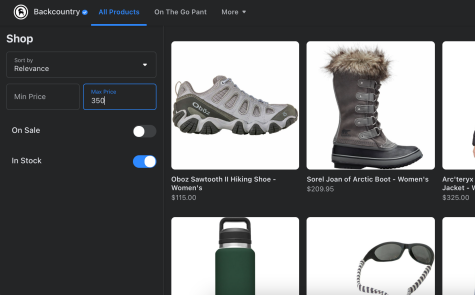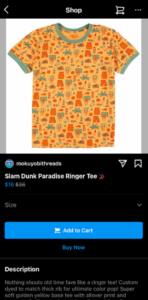The Rise of Social Commerce: What You Need to Know

Take a moment and ask yourself, what is your preferred shopping experience? Traditionally, our shopping habits have been driven by in-person retailers. You go to a brick and mortar store, chat with a sales associate, and get hands-on experience with a product before you purchase. But as social media has evolved into a digital destination for consumers to learn more about their favorite brands, eCommerce retailers have seen tremendous growth, quadrupling their total sales over the past seven years.
This boom was catalyzed in 2020 as the world stayed indoors and online. However, this presented an entirely new challenge for businesses. How do you reimagine the shopping experience to address both current events and modern consumer trends? The answer is social commerce, where brands transform their social media accounts into eCommerce platforms.
You may say to yourself, “Well, that doesn’t seem to be new. I’ve been able to make purchases on Facebook for years!” And that’s true, social commerce isn’t a new concept.
Facebook first introduced their “Buy” button way back in 2014. But social commerce’s popularity has surged in recent years because it’s a shopping experience that can speak directly to changing consumer behavior. You don’t have to coax potential buyers off a third-party platform and onto your eComm store. You can confine the entire path to purchase to the one place your customers are always on: social media.
RELATED: 5 Best eCommerce Product Videos to Boost Conversions
Considering that everyone and their grandparents are on at least one social channel, social commerce’s potential to reach any consumer, from anywhere in the world, should be abundantly clear. And with this selling strategy relatively in its infancy, jumping on the bandwagon now can position your brand as a leader in this new frontier of eCommerce shopping.
But like any hot new buzzword, you may still be asking yourself: what does “social commerce” really mean? We’ll dive into why this new business model has caught fire, some hard statistics to back up the facts, and highlight the platforms you need to leverage to boost your sales through social commerce.
Why Social Commerce is Rising
Social Commerce: A Solution for Data Privacy?
Social Commerce by the Numbers
The Rise of Social Commerce: The Takeaway
Why Social Commerce is Rising
It’s never been easier to make a purchase online. With just a quick Google search, you can instantly find products, compare them to other brands, and buy them straight from a website. The last few years have proven, however, that customers are relying more on social media to inform their purchasing decisions. Almost one-fifth of US consumers have now made online purchases either through a buy button, or clicking a shoppable post, on a social channel. Essentially, that’s all social commerce means: it’s a way for consumers to research and purchase products directly through a social media platform.
What social commerce aims to do is interlink eCommerce and social media to break down any digital roadblocks that could prevent a customer from moving down the path to purchase. You don’t want to force your customers to click through multiple product pages, or wait for a targeted ad, to make a purchase.
From discovery to conversion, with social commerce, customers can do all of their shopping without having to navigate away from your brand’s social profile. This effectively closes any off-ramps a consumer might take in the traditional eCommerce experience that would stop them from clicking ‘Buy Now’. If you want to completely streamline the buying process, then you need to latch onto social commerce.
Learn More: Social Media Video Ad Specs & Placements Guide
Why Do Customers Shop on Social Media?
As you ruminate on how you can deploy a social commerce strategy, think about how you personally use social media when making a purchasing decision. What aspects of the social experience inspire you to reach for your wallet?
Social commerce is so enticing because social media is how modern consumers find out what’s currently trendy or fashionable. They don’t want to just be told what to buy; they want to know why they should buy it and–most importantly–how they’ll look and feel after making that purchase.
Think of it like this: have you ever wanted to buy a pair of shoes, but had zero clue what it would look like on you because your only reference was a product image on a static white background? Likely if you want to see how a product looks in real life, you aren’t navigating to an eCommerce website, but researching a brand’s social profile to find the exact product you have your eye on. Similarly, brand’s aim to establish a sense of community with their products. When consumers navigate to their social profiles, they want to know if a brand’s style will vibe with their own.
This is the central power of social media’s role in a purchasing decision: it gives customers a better idea of what they gain from using your product.
Take a clothing brand like Andie for example. A customer might check out their social media channels to get a better understanding of their aesthetic and culture. But a central reason why they’ve amassed over 100k followers on Instagram is because it allows their customers to see what their clothing looks like on an actual human body.

Andie uses a diverse range of talent that feels relatable and authentic to their core consumers, engaging not only a deeper understanding, but a greater appreciation, for what they’re selling.
How Social Proof Drives Social Commerce
One reason why social commerce has grown over the last few years–aside from major world events–is the increasing power of social proof that affects our purchasing habits. Consider the weight that social proof has: how many times have you bought something because a friend or celebrity did?
But social proof is more than just free word-of-mouth advertising. It can also encompass the product reviews on your website, comments section of your social commerce store, or even the on-camera talent you feature. A recent report found that approximately 86% of consumers view product reviews as an essential aspect when researching and selecting products to buy.
Social Commerce: A Solution for Data Privacy?
Third-party cookies are going bye-bye. Their retirement has rocked the digital boat because their power to track consumer interests and target audiences with high intent has been a boon for brands.
As new data privacy restrictions come into effect, audience tracking is becoming far more complicated. You will need to find alternative ways to reach your core consumers, and a viable solution is social commerce.
The audience demographics for the major social networks are publicly available. Even though targeting will be limited, you can still promote your products to the audience you need by boosting your presence on the platforms where your target audiences congregate. You may not be able to get granular data, but this is a workaround you can employ immediately to find customers that are becoming hard to reach.
LEARN MORE: The Shifting Paradigm of Data Privacy
As social commerce continues to evolve, platforms are experimenting with ways to make the social shopping experience even more unique. Enter: shoppable live streams.
Think of them like the modern version of home shopping networks, where consumers can see the product being demonstrated live and make a purchase instantly without having to navigate away from the stream. Brands like Walmart have already begun testing shoppable live streams on apps like TikTok, and we predict this unique sales channel will continue to extend in the coming years.
Social Commerce by the Numbers
Every marketer knows that anecdotal information will only get you so far in convincing your CEO or CMO about the importance of social commerce. Your C-suite team wants to see the empirical evidence proving why they should invest in this emerging eCommerce trend.
Use these hard data points to illustrate to your team why your brand needs to jump on the social commerce train sooner rather than later.
- Social commerce buyers in the US accelerated 25.2% to 80.1 million in 202
- Social commerce will grow another 12.9% to 90.4 million in 2021.
- By 2027, it’s projected that social commerce will drive $604 billion in sales.
- 85% of people globally shop online.
- 30% of Online Shoppers Say They’re Likely to Make a Purchase Through Social Media
- 48% of 18-34 year old internet users have made a purchase through social media
- 87% of users turn to social media for help in making a shopping decision.
- Over 1/3 of U.S. internet users connect with brands on social media to learn more about their products and services.
- In 2021, there will be 3.78 billion social media users, an increase of 47% over the last decade
- In 2021, 91.9% of U.S. marketers will use social media for marketing purposes.
Best Platforms for Social Commerce
That said, not every social channel is primed for social commerce, at least not yet. Snapchat is just beginning to invest in social commerce integrations through augmented reality so consumers can quite literally picture themselves using a product.
Since the trend is still catching fire, you can focus all of your attention on the top performing social commerce platforms rather than trying to strategize across the entire spectrum of social media.
And by getting in on the social commerce trend now, you’ll be set up to easily adapt your content to every channel as new platforms emerge.
These are the best social commerce platforms you can leverage today.
There are over 250 million people interacting with Facebook’s social commerce platform, Facebook Shops, every month. Brands selling on Facebook get access to a customizable digital storefront where they can promote their products through eye-catching images and video marketing content.

Brand products are listed on the platform and cross-promoted to other Facebook owned apps, like Instagram Shops. Expect social commerce to remain a major focus for Facebook in the coming year as they continue to expand on Shops, making it easier for brands to customize the user experience, and for consumers to purchase products in-app.
Facebook is also adding new features so consumers can directly message brands, committing to their original mission statement to make it easier for people to make new connections online. As the platform also sets its sights on live-stream shopping experiences, Facebook’s social commerce integration is set to shape what this evolving industry will look like for years to come.

As Instagram sees 130 million people every month click on a shoppable post, the platform continues to invest in building out their social shopping experience: Instagram Shops. Within the platform, users can browse an entire catalogue of products and make a purchase directly in-app without having to navigate away to a third-party product landing page.
As Forbes points out, “A user’s ability to buy natively through Instagram radically shortens the buyer journey allowing businesses to easily find, inspire and convert a window shopper into a customer.”
Brands of all sizes will find success engaging their large base of social media followers, but Instagram Shops will particularly benefit smaller businesses and individual artisans. Even if you don’t have a huge following, listing your products on an Instagram Shop will expose your brands to the platform’s 1.16 billion monthly active users.
Pinterest
As Pinterest continues to innovate how we search online, the platform has also made it easy for brands to sell directly in-app. Brands can upload their entire catalogue of products, and Pinterest will automatically convert them into shoppable Product Pins.

Pinterest also offers shopping recommendations based on products that a user has previously pinned, as well as machine learning functionality like Shop the Look, which uses artificial intelligence to identify products in a single image that can then be purchased on the platform.
47% of Americans use Pinterest as a primary source to find and purchase products. In comparison, 15% of consumers went to Facebook, and 11% went to Instagram.
With 72% of Pinners saying they feel inspired to make a purchase off the platform even when they aren’t actively shopping, the potential to convert customers and increase your ROI through social commerce on Pinterest couldn’t be more apparent.
Pinterest is a platform that helps users decide what they want to purchase, so your brand must be part of that conversation. And as the platform has its own diverse, platform-loyal demographic of users, Pinterest can be an effective new tool to target consumers that are becoming harder to reach.
TikTok

TikTok is increasingly becoming a powerful platform for social commerce.
In 2019, grocery retailer Kroger became the first company to experiment with selling a product directly on TikTok through a branded hashtag challenge that funneled customers to a dedicated in-app product landing page. The hashtag resulted in 447 million views across multiple user generated videos on the platform. The following year, TikTok’s Chinese equivalent Douyin brought in over $122 million in revenue from social commerce integrations.
Currently brand’s on TikTok can include a link to their eCommerce store on their TikTok profile. As the platform continues to embrace the emerging eCommerce trend, TikTok is setting itself up to become a true full-funnel marketing channel, especially with their fleet of new social commerce features slated for release in the coming year.
Soon, brands will be able to showcase their entire catalogue natively on the app, host live stream shopping events, and TikTokers can even try their hands at affiliate marketing. TikTok’s biggest personalities will be able to drive consumers to your brand’s product landing pages or eComm stores and receive automatic commissions when a sale is made.
The Rise of Social Commerce: The Takeaway
The pandemic drove the world online, and we took our wallets with us. But eCommerce isn’t just for luxury items anymore. We’re buying basic necessities online—from groceries to toilet paper. This has pushed traditional brick and mortar retailers into the digital realm to create shopping experiences that meet customers where they are: at home, and on social media.
Throughout 2020, eCommerce growth surged by 30%, accelerating shopping trends by more than two years. And as more and more consumers go to social media to get inspired to make a purchase, social commerce has gradually become one of our new favorite way to shop online.
To serve users’ evolving lifestyles, every major social platform will continue to invest in building out their social shopping experiences in the coming year. This means more opportunities for your brand to bridge the gap between the online and in-person shopping experience.
We spend so much of our time on social media platforms that it’s no-brainer why social shopping has been on the rise. As its popularity increases over the coming years, retailers will need to continue to lean into social commerce as an out-of-the-box way to drive sales and grow their brand.
FREE DOWNLOAD: The Ultimate Creative Guide to eCommerce Video
Do More with Video
Learn how we can help you produce more quality videos affordably and at scale.



